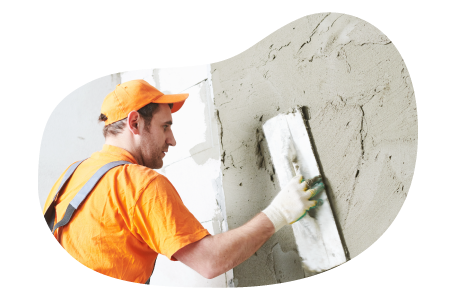Necessary Tools and Strategies for Professional Plastering in the house
A Comprehensive Overview to Learning Plastering Skills for Your Renovation Needs

Important Tools and Products
Various necessary devices serve distinctive objectives, ensuring effectiveness and precision throughout the plastering procedure. A top quality trowel, for circumstances, is essential for applying and smoothing plaster, while a hawk offers a secure platform for holding the material.
Along with devices, selecting the appropriate plastering products is important. Gypsum-based plasters are frequently preferred for their convenience and convenience of use, while cement-based choices are ideal for exterior applications because of their longevity. Water and bonding agents play significant roles in attaining proper consistency and adhesion, guaranteeing that the plaster sticks successfully to the surface area.
In addition, safety equipment such as handwear covers, masks, and safety glasses is crucial to guard versus dust and irritability during the application process. By setting up the right combination of materials and tools, plasterers can boost their ability and produce top notch coatings, inevitably raising the total craftsmanship of their work.
Preparing Surfaces for Plastering
Accomplishing a smooth and sturdy plaster coating starts with meticulous prep work of the surfaces to be smudged. This fundamental action is vital to making sure attachment and the longevity of the plaster. Begin by evaluating the problem of the substrate-- whether it is drywall, stonework, or concrete-- eliminating any kind of loosened paint, dirt, or debris that may hinder bonding.
Following, fix any blemishes such as holes or splits. Make use of an ideal filler to attain a degree surface; this can be important for protecting against future problems. As soon as fixed, make certain the surface is tidy and dry, as moisture can endanger plaster adherence.
For permeable surface areas, it is advisable to apply a bonding representative. This product improves adhesion and develops a dependable interface between the plaster and substrate. If collaborating with formerly plastered surfaces, it may be essential to scuff or sand the location lightly to supply a key for the brand-new plaster layer.
Smudging Strategies and Tips
Understanding gluing strategies calls for both skill and practice to attain a perfect finish. One necessary strategy is the application of the plaster in multiple slim layers, rather than a solitary informative post thick layer.
When using the finish coat, employ a shoveling strategy that includes holding the trowel at a minor angle and functioning in a circular activity. This assists to create a smooth surface area and reduces the appearance of trowel marks. In addition, maintain a spray bottle of water convenient to haze the surface lightly; this maintains the plaster convenient and enables smoother ending up.
Timing is critical; job effectively, as the plaster starts to set. When the plaster has firmed up yet is still damp, make use of a moist sponge to carefully smooth the surface better. Finally, enable ample drying out time before sanding or painting, ensuring your difficult job results in an expert, top notch coating.
Common Mistakes to Prevent

Another typical mistake is applying plaster too thickly. Excitable applications can bring about fracturing and long term drying times. It's vital to use plaster in slim, even layers, allowing each layer to dry adequately prior to including a lot more.
In addition, not using the right tools can impede the top quality of the coating. Utilizing improper trowels or mixers can produce inconsistencies in the plastering process. Always choose premium devices made for smudging tasks.
Last but not least, lots of individuals underestimate the importance of timing. Operating in inappropriate temperature levels or humidity levels can adversely influence plaster drying out and healing. It is recommended to inspect weather condition conditions and adjust your timetable as necessary.
Ending Up Touches for a Professional Look
The lasts of a smudging task are essential for accomplishing a polished, specialist appearance. When i was reading this the plaster has dried sufficiently, the following action is to analyze the surface for flaws. Minor bumps, openings, or irregular areas should be resolved using great sandpaper or a fining sand block. This thorough interest to information is vital for making certain a smooth finish.
After fining sand, it's suggested to cleanse the surface to eliminate any type of dust and particles. A wet cloth is efficient for this function, complied with by an extensive drying duration. If essential, applying a slim layer of ending up plaster can enhance the surface better, giving a seamless finish.
As soon as the finishing plaster is completely dry, another round of sanding may be required to achieve the preferred level of smoothness. Lastly, think about using a primer prior to painting or wallpapering, which will certainly enhance bond and longevity.
Verdict
Understanding gluing skills substantially improves the quality of restoration tasks. An extensive understanding of necessary devices, surface area preparation, and efficient strategies is important for accomplishing expert results. Awareness of common mistakes allows for the avoidance of costly mistakes, while see this here interest to completing touches makes certain a sleek look. Inevitably, the combination of these aspects adds to the production of smooth, durable surfaces that raise the visual worth of any kind of area, underscoring the significance of proficient plastering in home renovation ventures.
Water and bonding agents play significant functions in achieving correct consistency and bond, guaranteeing that the plaster sticks effectively to the surface area. Plastering.


Furthermore, keep a spray container of water handy to haze the surface area gently; this keeps the plaster convenient and allows for smoother ending up. (Plastering)
If required, applying a slim layer of completing plaster can enhance the surface further, giving a seamless surface.